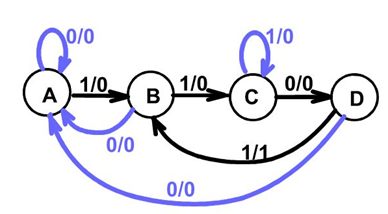Sequence Detector
Prerequisites: Study the functionality of Sequence Detector
Learning Objective: To develop the source code for sequence detector (sequence 1101) by using VERILOG and obtain the simulation and synthesis.
Software and Hardware: Xilinx ISE 9.2i and FPGA Spartan-3E.
Theory:
A sequence detector accepts as input of a string of bits: either 0 or 1. Its output goes to 1 when a target sequence has been detected. There are two basic types: overlap and non-overlap. In a sequence detector that allows overlap, the final bits of one sequence can be the start of another sequence. The present example is 1101 sequence detector. It raises an output of 1 when the latest binary bits received are 1101.

Verilog Code:
/* This design models a sequence detector using Mealy FSM.
Whenever the sequence 1101 occurs, output goes high. */
module firstFSM (
input wire clk,
input wire rst,
input wire sequence,
output reg tick
);
// State declarations
localparam a = 2'b00;
localparam b = 2'b01;
localparam c = 2'b10;
localparam d = 2'b11;
// Signals
reg presentState;
reg nextState;
// State assignments
always @ (posedge clk, posedge rst)
begin
if(rst) presentState <= a;
else if(clk) presentState <= nextState;
end
// Next state logic
always @ *
begin
// Default or unassigned states remain same
nextState = presentState;
tick = 1'b0;
case(presentState)
a : if(sequence) nextState = b;
b :
begin
if(sequence) nextState = c;
else nextState = a;
end
c : if(~sequence) nextState = d;
d :
begin
if(sequence)
begin
tick = 1'b1;
nextState = b;
end
else nextState = a;
end
default :
begin
tick = 1'b0;
nextState = a;
end
endcase
end
endmodule
TEST BENCH
`timescale 1 ns / 1 ns
module firstFSMTest;
// Signals
reg clk, rst;
reg sequence;
wire tick;
// Initialise reg ports
initial
begin
clk = 1'b0;
sequence = 1'b0;
end
// Set initial reset
initial
begin
rst = 1'b1;
#30 rst = 1'b0;
end
// Set occurance of sequence
initial
begin
#30 sequence = 1'b1;
#20 sequence = 1'b0;
#20 sequence = 1'b0;
#20 sequence = 1'b1;
#20 sequence = 1'b1;
#20 sequence = 1'b0;
#20 sequence = 1'b1;
#20 sequence = 1'b0;
#20 sequence = 1'b1;
end
// Initialise uut
firstFSM uut (.clk(clk),
.rst(rst),
.sequence(sequence),
.tick(tick)
);
always #10 clk = ~clk;
endmodule
Simulation results:
Result: Thus the program for sequence detector has been verified and also simulation and synthesis reports have been verified.
Learning outcome: After completion of this experiment, students are able to design sequence detector using Verilog code.
-
UpdatedOct 15, 2016
-
Views6,066
